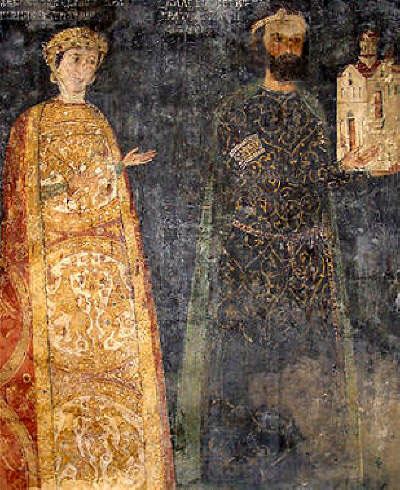 | ||
Sebastokratōr (Greek: σεβαστοκράτωρ; Bulgarian and Serbian Cyrillic: Севастократор; both pronounced sevastokrator) was a senior court title in the late Byzantine Empire. It was also used by other rulers whose states bordered the Empire or were within its sphere of influence (Bulgarian Empire, Serbian Empire). The word is a compound of "sebastos" ("venerable", the Greek equivalent of the Latin Augustus) and "kratōr" ("ruler", the same element as is found in "autokratōr", "emperor"). The wife of a sebastokratōr was named sebastokratorissa (Greek: σεβαστοκρατόρισσα) in Greek or sevastokratitsa (Cyrillic: севастократица) in Serbian and Bulgarian.
Contents
History
The title was created by Emperor Alexios I Komnenos (r. 1081–1118) to honour his elder brother Isaac Komnenos. According to Anna Komnene, Alexios did this to raise Isaac above the rank of Caesar, which he had already promised to his brother-in-law, Nikephoros Melissenos. Anna Komnene compares the rank of sebastokratōr to "a second emperor", and also records that along with the Caesar a sebastokratōr was granted the right to wear a crown (but not the imperial diadem). During the Komnenian dynasty (1081–1185), the title continued to be the highest below that of Emperor until 1163, when Emperor Manuel I created the title of despotēs. During that period, it was given exclusively to members of the imperial family, chiefly younger sons of the emperor.
After the dismemberment of the Byzantine Empire by the Fourth Crusade in 1204, the title was adopted in the Latin Empire, the Empire of Nicaea, and the Bulgarian Empire. In Nicaea and the post-1261 restored Byzantine Empire, the title remained one of the highest court dignities, and was almost always restricted to members of the imperial family. The last known holder of the title was Demetrios Kantakouzenos, a ruler in the Peloponnese in the late 14th century.
According to the sources, the distinctive colour associated with the title was blue: the sebastokratōr′s ceremonial costume included blue stockings and blue boots. In circa 1260, according to George Akropolites, the sebastokratores who were members of the imperial family were distinguished from those who were not by having embroidered golden eagles on their shoes. By the time of pseudo-Kodinos in the mid-14th century, the insignia associated with the rank were a skiadion hat in red and gold, decorated with gold-wire embroideries, with a veil bearing the wearer's name and pendants identical to those of the despotēs. He wore a red tunic (rouchon) similar to the emperor's, but without the rizai decorations and the insignia of military power. His mantle (tamparion) was no longer known, but the stockings were blue; under John VI Kantakouzenos (r. 1347–54), however, when the emperor raised his brothers-in-law Manuel and John Asanes to the rank, he permitted them to wear tamparia and stockings like those of the despotēs. The sebastokratōr's shoes and stockings were blue, with gold-embroidered eagles on red background; and his horse tack was also of blue, his saddle blanket featuring furthermore four red-embroidered eagles. His tent was white with blue decorations. The form of the domed skaranikon, on the other hand, for the sebastokratōr was unknown to pseudo-Kodinos. The sebastokratōr also had the prerogative of signing documents with a special blue ink.
Bulgaria
Kaloyan inherited the title possibly from his father Aleksandar (d. after 1232), a son of Ivan Asen I of Bulgaria (r. 1189–1196).
Serbia
This title was also adopted in the court of medieval Serbia, under the Nemanjić dynasty, the Serbian Kings and Emperors (1217–1346; 1346–1371).
